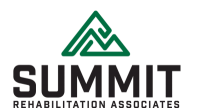WHAT IS ERGONOMICS?
Ergonomics is the practice of “fitting the work to the worker.” This includes the evaluation of tools, machines, systems, and work methods with the goal of increasing worker productivity, safety and comfort.
PROGRAM SUMMARY
Summit Rehabilitation’s therapists have extensive experience in providing ergonomic consulting services. Our therapists have established themselves as community leaders in the field. The diverse background of our staff allows for expertise across the vast spectrum of ergonomics.
We provide result oriented, cost effective solutions to meet a variety of ergonomic needs. Our approach is client oriented and individualized. We rely on state of the art principles and research to guide our evidence-based approach. Each of our staff routinely attends continuing education courses and conferences to ensure that our interventions reflect recent research practices and product knowledge.
INDIVIDUAL JOBSITE ASSESSMENTS
Appropriate for:
• Workers who recently returned to work following an injury or want to return to work
• Workers currently performing modified duty or with medical restrictions
Goals:
• Keep worker on the job
• Reduce time off work
• Improve productivity
• Transition from modified duty to full duty work status
Process:
• Evaluate worker performing routine job tasks
• Identify and quantify physical requirements of the job
• Evaluate equipment and tools used in the job process
• Match the job demands to the workers abilities and determined restrictions
• Teach workers to work “smarter,” not “harder”
• Educate worker in alternative work methods to reduce ergonomic risk factors
• Teach worker appropriate stretching and stress relieving exercises to remain healthy
Provide:
• Written report with digital photos describing short and long term solutions
• Recommendations for work method changes to decrease ergonomic risk or accommodate injury
• Recommend ergonomic equipment and tools to reduce ergonomic risk and accommodate work restrictions
• Provide vendor contacts for appropriate cost effective equipment
• Recommendations for modified duty task that are within workers abilities and identified restrictions
• Assistance with a process for a gradual return to full duty status
PREVENTATIVE ERGONOMIC ANALYSIS
Appropriate for:
• Jobs identified as high risk for injury or worker complaints (red flag jobs)
• High incidence of similar injury reports or sprains/strains
Goals:
• Reduce ergonomic risk factors
• Reduce injuries and illnesses, which reduce workers’ compensation and medical costs
• Reduce time loss days
• Provide employees with a safe and productive work environment free from recognized hazards
• Increase worker productivity and efficiency
• Increase product output and quality
• Increase work safety
Process:
• Review OSHA 300 and injury logs
• Administer employee surveys, if appropriate
• Evaluate multiple workers performing routine job tasks
• Identify and quantify the physical requirements, repetitive requirements and postural demands of the work tasks
• Identify ergonomic risk factors including awkward postures, forces and repetition and prioritize high risk job tasks
• Evaluate tools and equipment
• Perform a systems analysis of the efficiency of work flow
Provide:
• Written report with digital photos describing short and long term solutions
• Recommendations for work method changes to decrease ergonomic risk factors
• Recommendations for modifications to make jobs easier and reduce strain
• Recommendations for ergonomic equipment and tools to reduce ergonomic risk factors
• Vendor contacts for appropriate cost effective equipment and tools
• Recommendations for internal controls such as job rotation and work rotation to reduce repetition
